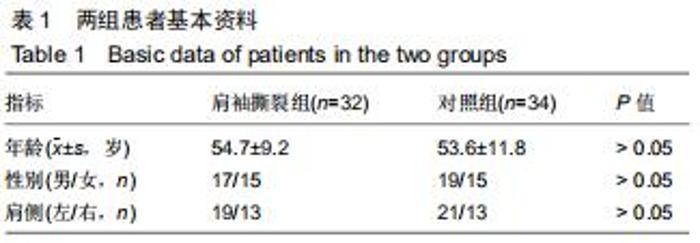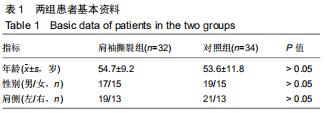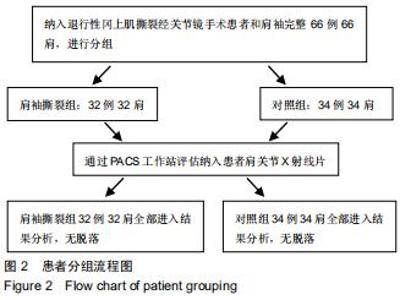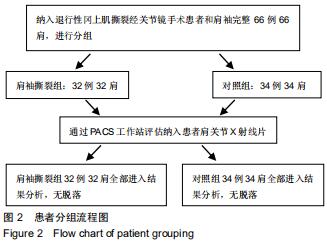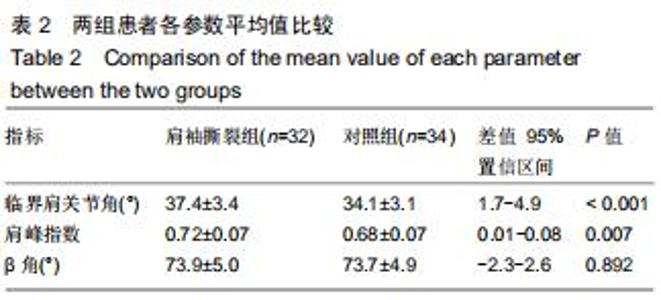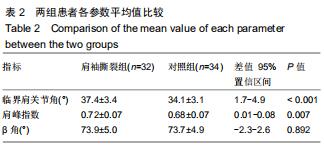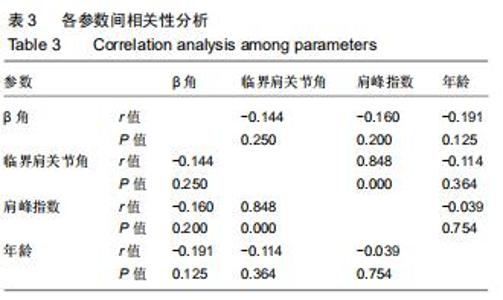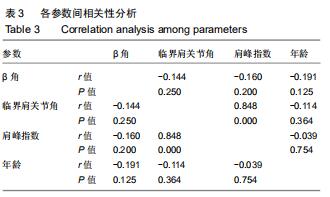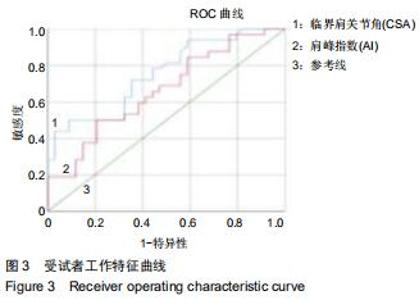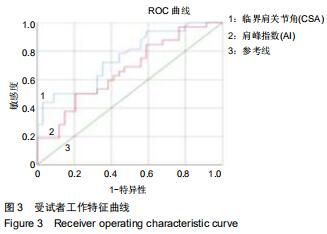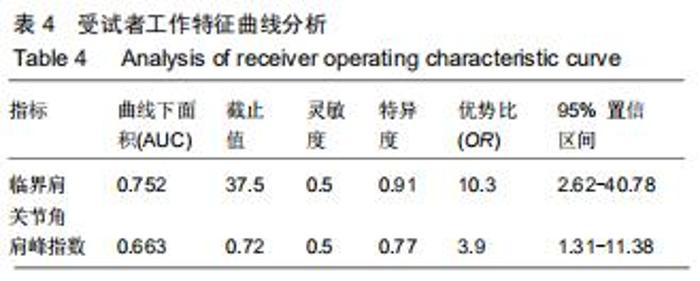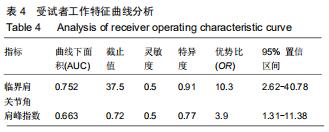Chinese Journal of Tissue Engineering Research ›› 2020, Vol. 24 ›› Issue (35): 5644-5649.doi: 10.3969/j.issn.2095-4344.2923
Previous Articles Next Articles
Clinical study on the relationship between critical shoulder joint angle and degenerative rotator cuff tear
Huo Yanxu, Yang Zhi, Pei Fang, Chen Xiangyang
Affiliated Hospital of Xuzhou Medical University, Xuzhou 221000, Jiangsu Province, China
-
Received:2019-12-19Revised:2019-12-25Accepted:2020-02-26Online:2020-12-18Published:2020-10-17 -
Contact:Chen Xiangyang, MD, Chief physician, Associate professor, Affiliated Hospital of Xuzhou Medical University, Xuzhou 221000, Jiangsu Province, China -
About author:Huo Yanxu, Master candidate, Affiliated Hospital of Xuzhou Medical University, Xuzhou 221000, Jiangsu Province, China
CLC Number:
Cite this article
Huo Yanxu, Yang Zhi, Pei Fang, Chen Xiangyang. Clinical study on the relationship between critical shoulder joint angle and degenerative rotator cuff tear[J]. Chinese Journal of Tissue Engineering Research, 2020, 24(35): 5644-5649.
share this article
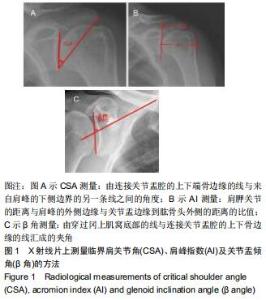
根据MOOR等[10]的研究,临界肩关节角由连接关节盂腔的上下端骨边缘的线与来自肩峰的下侧边界的另一条线之间的角度(图1A)。 肩峰指数AI则根据NYFFELER等[12]的研究定义为:肩胛关节的距离与肩峰的外侧边缘(glenoid to the lateral margin of the acromion,GA)与关节盂边缘到肱骨头外侧(glenoid rim to the lateral aspect of the humeral head,GH)的距离的比值(AI=GA/GH,图1B)。 关节盂的倾角以β角来评估,如MAURER等[13]所述:由穿过冈上肌窝底部的线与连接关节盂腔的上下骨边缘的线汇成的夹角(图1C) 。 "
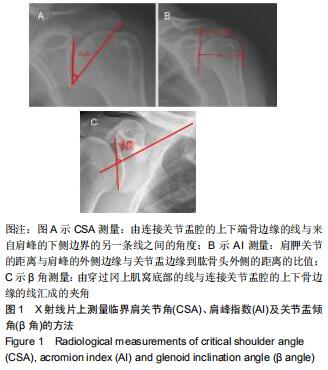
|
[1] 朱鸣镝,汤锦波,凌树才,等.肩关节运动时肌肉力臂改变的实验研究[J].中国临床医学,2007,14(2):221-225.
[2] HUEGEL J, WILLIAMS AA, SOSLOWSKY LJ. Rotator cuff biology and biomechanics: a review of normal and pathological conditions. Curr Rheumatol Rep. 2015;17(1): 476.
[3] CHAKRAVARTY K, WEBLEY M. Shoulder joint movement and its relationship to disability in the elderly. J Rheumatol. 1993;20(8):1359-1361.
[4] BAUMGARTEN KM, GERLACH D, GALATZ LM, et al. Cigarette smoking increases the risk for rotator cuff tears. Clin Orthop Relat Res. 2010;468(6):1534-1541.
[5] ABBOUD JA, KIM JS. The effect of hypercholesterolemia on rotator cuff disease.Clin Orthop Relat Res. 2010;468(6): 1493-1497.
[6] HARVIE P, OSTLERE SJ, TEH J, et al. Genetic influences in the aetiology of tears of the rotator cuff.Sibling risk of a full-thickness tear. J Bone Joint Surg Br. 2004;86(5):696-700.
[7] NEER CS 2nd. Anterior acromioplasty for the chronic impingement syndrome inthe shoulder: a preliminary report. J Bone Joint Surg Am. 1972;54(1):41-50
[8] HASHIMOTO T, NOBUHARA K, HAMADA T. Pathologic evidence of degeneration as a primary cause of rotator cuff tear. Clin Orthop Relat Res. 2003;(415):111-120.
[9] SOSLOWSKY LJ, THOMOPOULOS S, ESMAIL A,et al. Rotator cuff tendinosis in an animal model: role of extrinsic and overuse factors. Ann Biomed Eng.2002;30(8):1057-1063.
[10] MOOR BK, BOUAICHA S, ROTHENFLUH DA,et al. Is there an association between the individual anatomy of the scapula and the development of rotator cuff tears or osteoarthritis of the glenohumeral joint?: A radiological study of the critical shoulder angle. Bone Joint J. 2013;95-B(7):935-941.
[11] SUTER T, GERBER POPP A, ZHANG Y, et al. The influence of radiographic viewing perspective and demographics on the critical shoulder angle. J Shoulder Elbow Surg. 2015;24(6): e149-158.
[12] NYFFELER RW, WERNER CM, SUKTHANKAR A, et al. Association of a large lateral extension of the acromion with rotator cuff tears. J Bone Joint Surg Am. 2006;88(4): 800-805.
[13] MAURER A, FUCENTESE SF, PFIRRMANN CW, et al. Assessment of glenoid inclination on routine clinical radiographs and computed tomography examinations of the shoulder. J Shoulder Elbow Surg. 2012;21(8):1096-1103.
[14] MIYAZAKI AN, ITOI E, SANO H, et al. Comparison between the acromion index and rotator cuff tears in the Brazilian and Japanese populations. J Shoulder Elbow Surg. 2011;20(7): 1082-1086.
[15] WATANABE A, ONO Q, NISHIGAMI T, et al. Association between the Critical Shoulder Angle and Rotator Cuff Tears in Japan. Acta Med Okayama. 2018;72(6):547-551.
[16] GOMIDE LC, CARMO TCD, BERGO GHM, et al. Relationship between the critical shoulder angle and the development of rotator cuff lesions: a retrospective epidemiological study. Rev Bras Ortop. 2017;52(4):423-427.
[17] GERBER C, SNEDEKER JG, BAUMGARTNER D, et al. Supraspinatus tendon load during abduction is dependent on the size of the critical shoulder angle: A biomechanical analysis. J Orthop Res. 2014;32(7):952-957.
[18] CABEZAS AF, KREBES K, HUSSEY MM, et al. Morphologic Variability of the Shoulder between the Populations of North American and East Asian. Clin Orthop Surg. 2016;8(3): 280-287.
[19] 陈剑. 肩关节关键角(CSA)与肩袖损伤的相关性研究[A]//浙江省医学会骨科学分会、浙江省医师协会骨科医师分会.2016年浙江省骨科学学术年会论文汇编[C].浙江省医学会骨科学分会、浙江省医师协会骨科医师分会:浙江省科学技术协会,2016:1. [20] KUM DH, KIM JH, PARK KM, et al. Acromion Index in Korean Population and Its Relationship with Rotator Cuff Tears. Clin Orthop Surg. 2017;9(2):218-222.
[21] BEELER S, HASLER A, GÖTSCHI T, et al. Critical shoulder angle: Acromial coverage is more relevant than glenoid inclination. J Orthop Res. 2019;37(1):205-210.
[22] RHEE SM, KIM JY, KIM JY, et al. The critical shoulder angle: can it be sufficient to reflect the shoulder joint without the humeral head? J Shoulder Elbow Surg. 2019;28(4):731-741.
[23] SINGLETON N, AGIUS L, ANDREWS S. The acromiohumeral centre edge angle: A new radiographic measurement and its association with rotator cuff pathology. J Orthop Surg (Hong Kong). 2017;25(3):2309499017727950.
[24] MELEAN P, LICHTENBERG S, MONTOYA F, et al. The acromial index is not predictive for failed rotator cuff repair. Int Orthop. 2013;37(11):2173-2179.
[25] CHURCHILL RS, BREMS JJ, KOTSCHI H. Glenoid size, inclination, and version: an anatomic study. J Shoulder Elbow Surg. 2001;10(4):327-332.
[26] HUGHES RE, BRYANT CR, HALL JM, et al, Blasier RB. Glenoid inclination is associated with full-thickness rotator cufftears. Clin Orthop Relat Res. 2003;(407):86-91.
[27] KANDEMIR U, ALLAIRE RB, JOLLY JT, et al. The relationship between the orientation of the glenoid and tears of the rotator cuff. J Bone Joint Surg Br. 2006;88(8): 1105-1109.
[28] CHALMERS PN, BECK L, GRANGER E, et al. Superior glenoid inclination and rotator cuff tears. J Shoulder Elbow Surg. 2018;27(8):1444-1450.
[29] DAGGETT M, WERNER B, COLLIN P, et al. Correlation between glenoid inclination and critical shoulder angle: a radiographic and computed tomography study. J Shoulder Elbow Surg. 2015;24(12):1948-1953.
[30] WATANABE A, ONO Q, NISHIGAMI T, et al. Differences in Risk Factors for Rotator Cuff Tears between Elderly Patients and Young Patients. ActaMed Okayama. 2018;72(1):67-72. [31] LAZARIDES AL, ALENTORN-GELI E, CHOI JH,et al. Rotator cuff tears in young patients: a different disease than rotator cuff tears in elderly patients. J Shoulder Elbow Surg. 2015; 24(11):1834-1843. |
| [1] | Zhu Xuefen, Huang Cheng, Ding Jian, Dai Yongping, Liu Yuanbing, Le Lixiang, Wang Liangliang, Yang Jiandong. Mechanism of bone marrow mesenchymal stem cells differentiation into functional neurons induced by glial cell line derived neurotrophic factor [J]. Chinese Journal of Tissue Engineering Research, 2021, 25(7): 1019-1025. |
| [2] | Wang Zhengdong, Huang Na, Chen Jingxian, Zheng Zuobing, Hu Xinyu, Li Mei, Su Xiao, Su Xuesen, Yan Nan. Inhibitory effects of sodium butyrate on microglial activation and expression of inflammatory factors induced by fluorosis [J]. Chinese Journal of Tissue Engineering Research, 2021, 25(7): 1075-1080. |
| [3] | Jiao Hui, Zhang Yining, Song Yuqing, Lin Yu, Wang Xiuli. Advances in research and application of breast cancer organoids [J]. Chinese Journal of Tissue Engineering Research, 2021, 25(7): 1122-1128. |
| [4] | Huang Dengcheng, Wang Zhike, Cao Xuewei. Intravenous, topical tranexamic acid alone or their combination in total knee arthroplasty: a meta-analysis of randomized controlled trials [J]. Chinese Journal of Tissue Engineering Research, 2021, 25(6): 948-956. |
| [5] | Zhan Fangbiao, Cheng Jun, Zou Xinsen, Long Jie, Xie Lizhong, Deng Qianrong. Intraoperative intravenous application of tranexamic acid reduces perioperative bleeding in multilevel posterior spinal surgery: a meta-analysis [J]. Chinese Journal of Tissue Engineering Research, 2021, 25(6): 977-984. |
| [6] | Yang Xin, Jin Zhe, Feng Xu, Lu Bing. The current situation of knowledge and attitudes towards organ, eye tissue, body donation of residents in Shenyang [J]. Chinese Journal of Tissue Engineering Research, 2021, 25(5): 779-784. |
| [7] | Zhang Guomei, Zhu Jun, Hu Yang, Jiao Hongwei. Stress of three-dimensional finite element models of E-MAX porcelain inlay [J]. Chinese Journal of Tissue Engineering Research, 2021, 25(4): 537-541. |
| [8] | Liu Fei, Cui Yutao, Liu He. Advantages and problems of local antibiotic delivery system in the treatment of osteomyelitis [J]. Chinese Journal of Tissue Engineering Research, 2021, 25(4): 614-620. |
| [9] | Ye Haimin, Ding Linghua, Kong Weihao, Huang Zutai, Xiong Long. Role and mechanism of hierarchical microchanneled bone scaffolds in promoting osteogenesis and angiogenesis [J]. Chinese Journal of Tissue Engineering Research, 2021, 25(4): 621-625. |
| [10] | Yu Langbo, Qing Mingsong, Zhao Chuntao, Peng Jiachen. Hot issues in clinical application of dynamic contrast-enhanced magnetic resonance imaging in orthopedics [J]. Chinese Journal of Tissue Engineering Research, 2021, 25(3): 449-455. |
| [11] | Huang Maomao, Hu Yue, Wang Binchuan, Zhang Chi, Xie Yujie, Wang Jianxiong, Wang Li, Xu Fangyuan. Bibliometric and visual analysis of international literature addressing ischemic stroke rehabilitation in recent 10 years [J]. Chinese Journal of Tissue Engineering Research, 2021, 25(23): 3725-3733. |
| [12] | Zhu Rui, Zeng Qing, Huang Guozhi. Ferroptosis and stroke [J]. Chinese Journal of Tissue Engineering Research, 2021, 25(23): 3734-3739. |
| [13] | Li Shanshan, You Ran, Guo Xiaoxiao, Zhao Lu, Wang Yanling, Chen Xi. Advances in the mechanisms of optic nerve regeneration [J]. Chinese Journal of Tissue Engineering Research, 2021, 25(23): 3740-3745. |
| [14] | Wang Zhen, Lin Haiqi, He Fei, Lin Wentao. Exercise activates skeletal muscle satellite cells: exercise prevention and treatment for age-related sarcopenia and muscle injury [J]. Chinese Journal of Tissue Engineering Research, 2021, 25(23): 3752-3759. |
| [15] | Song Shilei, Chen Yueping, Zhang Xiaoyun, Li Shibin, Lai Yu, Zhou Yi. Potential molecular mechanism of Wuling powder in treating osteoarthritis based on network pharmacology and molecular docking [J]. Chinese Journal of Tissue Engineering Research, 2021, 25(20): 3185-3193. |
| Viewed | ||||||
|
Full text |
|
|||||
|
Abstract |
|
|||||
